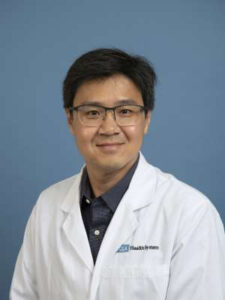The ACR’s Communications and Marketing Committee (CMC) is the organization’s megaphone. It spreads the word about new research and new standards of care and guidelines; helps deliver quality patient education materials; amplifies the ACR’s advocacy efforts for policies that impact patient care and physician fees (among other things); and highlights the specialty and rheumatic conditions through media outreach and our annual public relations campaign, Rheumatic Disease Awareness Month. and draws attention to upcoming studies to boost patient recruitment.

Dr. Yang
And that’s not all, says new CMC Chair Howard Yang, MD, RhMSUS, practicing rheumatologist at UCLA Health’s Santa Monica and Ronald Reagan Medical Centers and assistant professor in UCLA’s Division of Rheumatology. Dr. Yang began a three-year term as chair of the CMC last November. “Our job is to amplify these and all of the College’s efforts to reach as many ACR/ARP members as possible, as well as those rheumatology professionals who aren’t yet members so that we can do the most good for our patients,” he says.
The Rheumatologist (TR) asked Dr. Yang to describe the CMC and its important role in ensuring that clear, concise and important information gets into the hands of the the diverse audiences who need it.
TR: Why is an outreach committee needed today?
Dr. Yang: Information channels have changed. It’s no longer just about how many newspapers or magazines we can get to carry ACR stories. Today, it’s also about how we can get our messages amplified through many different forms of communication. For instance, we’re using things like Facebook and other social media platforms to boost ACR messaging; we’re working with what we call ACR ambassadors—social-media influencers—who are providing rheumatology information to their followers; and we use other mediums like podcasts, webinars, and email marketing to reach our audiences. Communication has changed, and we are adapting accordingly.
TR: How does the CMC go about that?
Dr. Yang: We introduce ourselves to the different ACR committees, including the education, quality of care, research, government affairs, workforce solutions and other committees, and invite them to use the CMC as a sounding board for how to get new information to the audiences they want to reach. Then we help by providing options. For instance, some members of the CMC serve as spokespersons and experts for media interviews; some use their connections with other organizations to inform the rheumatology community about the latest advances in treatments and research; and others share valuable feedback as first-line reviewers and testers for new product marketing. Our committee also manages the development and refinement of the ACR’s patient education library so that the materials are current, accurate, science-based and easy to understand and digest.
TR: Do you have any set goals for the CMC?
Dr. Yang: I am not solely focused on numbers of Facebook likes, social media reposts or other metrics like that. I’m also looking for a sense of a better integration of messages so we reach more people.
TR: How so?
Dr. Yang: Academic rheumatology departments may focus on CME guidelines, research centers on their studies, private practices on the latest guidelines for reimbursement. I want to bridge all that. Yes, research is important, but advocacy and reimbursement are going to affect your research, and if you can’t get patients to enroll in your study, your research is not going to happen. Yes, reimbursement rates have daily impacts for your private practice, but the latest research advancements and CME guidelines also impact the next generation of rheumatologists who will join your practice. It’s all related, and we need to consider the value of all these messages and how we can integrate them in our marketing and communication efforts. In the coming year and beyond, I would like to bridge these information gaps, so we realize that these are important topics for all of us, regardless of the lab or the practice we’re in.
TR: How did you get into rheumatology and then decide to volunteer for the ACR?
Dr. Yang: I had always planned to go into obstetrics and gynecology, as my father had, but during medical school, I met a pediatric rheumatologist (Suzanne C. Li, MD, at Hackensack University Medical Center at New Jersey) and got involved in a research project with her and three other pediatric rheumatologists. I still wasn’t sure whether to become an OB/GYN or rheumatologist, so I sent half of my applications for residency training in OB/GYN and the other half in internal medicine. I matched into internal medicine, so I decided I needed to go into rheumatology.
Once I became a fellow in rheumatology, I quickly saw some of the issues we face, such as the challenges with step therapy, and then saw an email from the ACR asking for fellows to sign up for Advocacy 101. I applied, I started volunteering in advocacy, then I was very lucky to get involved with the ACR Government Affairs Committee (GAC). As my term on the GAC was winding down, I was asked to join the CMC. I’m now looking forward to telling everyone about all the good things that the ACR is doing. Everybody has different perspectives, everybody has different needs. Through the CMC, let’s join together to help our colleagues and our patients.
Leslie Mertz, PhD, is a freelance science journalist based in northern Michigan.